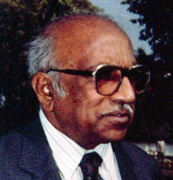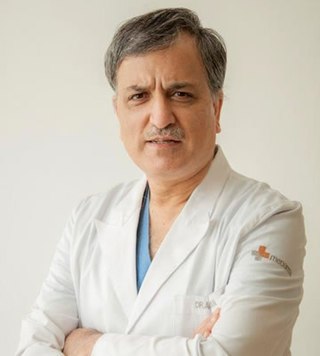
Cardiothoracic surgery is the field of medicine involved in surgical treatment of organs inside the thoracic cavity — generally treatment of conditions of the heart, lungs, and other pleural or mediastinal structures.

Cardiac surgery, or cardiovascular surgery, is surgery on the heart or great vessels performed by cardiac surgeons. It is often used to treat complications of ischemic heart disease ; to correct congenital heart disease; or to treat valvular heart disease from various causes, including endocarditis, rheumatic heart disease, and atherosclerosis. It also includes heart transplantation.
Walter Randolph "Ranny" Chitwood, Jr. is known for his work as a cardiothoracic surgeon at the Brody School of Medicine at East Carolina University located in Greenville, North Carolina.
The Dor procedure is a medical technique used as part of heart surgery and originally introduced by the French cardiac surgeon Vincent Dor (b.1932). It is also known as endoventricular circular patch plasty (EVCPP).
The Cox maze procedure, also known as maze procedure, is a type of heart surgery for atrial fibrillation.
David H. Adams is an American cardiac surgeon and the Marie-Josée and Henry R. Kravis Professor and Chairman of the Department of Cardiothoracic Surgery, Icahn School of Medicine at Mount Sinai Hospital in New York City. Dr. Adams is a recognized leader in the field of heart valve surgery and mitral valve reconstruction. As director of Mount Sinai Mitral Valve Repair Center, he has set national benchmarks with >99% degenerative mitral valve repair rates, while running one of the largest valve repair programs in the United States. Dr. Adams is the co-inventor of 2 mitral valve annuloplasty repair rings – the Carpentier-McCarthy-Adams IMR ETlogix Ring and the Carpentier-Edwards Physio II Annuloplasty Ring, and is a senior consultant with royalty agreements with Edwards Lifesciences. He is also the inventor of the Tri-Ad Adams Tricuspid Annuloplasty ring with a royalty agreement with Medtronic. He is a co-author with Professor Alain Carpentier of the benchmark textbook in mitral valve surgery Carpentier's Reconstructive Valve Surgery. He is also the National Co-Principal Investigator of the FDA pivotal trial of the Medtronic-CoreValve transcatheter aortic valve replacement device.
Gerald Murray Lawrie, M.D. is an American heart surgeon and pioneer in the surgical treatment of valvular heart disease of Australian descent.

Robert E. Michler is an American heart surgeon specializing in heart surgery, aortic and mitral valve repair, coronary artery bypass surgery, aneurysm surgery, and management of the failing heart. In 2017, Michler received the Vladimir Borakovsky Prize in Moscow from the Ministry of Health of the Russian Federation for “his personal contributions to the development of cardiovascular surgery”.
Minimally invasive cardiac surgery, also known as MICS CABG or the McGinn technique is heart surgery performed through several small incisions instead of the traditional open-heart surgery that requires a median sternotomy approach. MICS CABG is a beating-heart multi-vessel procedure performed under direct vision through an anterolateral mini-thoracotomy.
Endoscopic vessel harvesting (EVH) is a surgical technique that may be used in conjunction with coronary artery bypass surgery. For patients with coronary artery disease, a physician may recommend a bypass to reroute blood around blocked arteries to restore and improve blood flow and oxygen to the heart. To create the bypass graft, a surgeon will remove or "harvest" healthy blood vessels from another part of the body, often from the patient's leg or arm. This vessel becomes a graft, with one end attaching to a blood source above and the other end below the blocked area, creating a "conduit" channel or new blood flow connection across the heart.
Lars Georg Svensson is a cardiac surgeon and the chairman of the heart and vascular institute at Cleveland Clinic. He is the Director of the Aorta Center, Director of the Marfan Syndrome and Connective Tissue Disorder Clinic, and is a professor of surgery at Cleveland Clinic Lerner College of Medicine and Case Western Reserve University. He is also the Director of Quality Outcomes and Process Improvement for the Department of Thoracic and Cardiovascular Surgery and Affiliate Cardiac Surgery Program at Cleveland Clinic.

Apicoaortic Conduit (AAC), also known as Aortic Valve Bypass (AVB), is a cardiothoracic surgical procedure that alleviates symptoms caused by blood flow obstruction from the left ventricle of the heart. Left ventricular outflow tract obstruction (LVOTO) is caused by narrowing of the aortic valve and other valve disorders. AAC, or AVB, relieves the obstruction to blood flow by adding a bioprosthetic valve to the circulatory system to decrease the load on the aortic valve. When an apicoaortic conduit is implanted, blood continues to flow from the heart through the aortic valve. In addition, blood flow bypasses the native valve and exits the heart through the implanted valved conduit. The procedure is effective at relieving excessive pressure gradient across the natural valve. High pressure gradient across the aortic valve can be congenital or acquired. A reduction in pressure gradient results in relief of symptoms.
Gilles Dreyfus is a French cardiac surgeon.
Dr R Ravi Kumar graduated from Stanley Medical College and obtained the FRCS from Edinburgh. He worked at the Harefield Hospital, UK, under Sir Magdi Yacoub involving himself with adult cardiac surgery including heart and lung transplant and aortic homografts. Dr Ravi Kumar then underwent surgical residency in Boston, MA, United States. Following this he worked with Dr Albert Starr in Portland, Oregon. He pursued his cardiothoracic residency at the University of Texas, South Western Medical Center, Dallas, Texas, U.S. He continued at the same institution as an advanced fellow in Heart & Lung Transplant and is UNOS, certifiable for Heart & Lung Transplant.

Nagarur Gopinath was an Indian surgeon and one of the pioneers of cardiothoracic surgery in India. He is credited with the first successful performance of open heart surgery in India which he performed in 1962. He served as the honorary surgeon to two Presidents of India and was a recipient of the fourth highest Indian civilian award of Padma Shri in 1974 and Dr. B. C. Roy Award, the highest Indian medical award in 1978 from the Government of India.
Stanley John was an Indian cardiothoracic surgeon, a former professor at the Christian Medical College and Hospital (CMCH) and one of the pioneers of cardiothoracic surgery in India. He is reported to have performed the first surgical repairs of Ebstein's anomaly, Ruptured Sinus of Valsalva (RSOV) and Double Outlet Right Ventricle (DORV) in India. He assisted in performing the first open heart surgery in India while working at CMCH. During his tenure of 25 years at the institution, he mentored several known surgeons such as V.V. Bashi, A. G. K. Gokhale, J. S. N. Murthy and Ganesh Kumar Mani. Later, John joined Yellamma Dasappa Hospital, Bengaluru at the Department of Thoracic and Cardiovascular Surgery. He is an elected fellow of the National Academy of Medical Sciences, and the Government of India awarded him the fourth highest Indian civilian award of Padma Shri in 1975. He served as the 13th President of the Indian Association of Cardiovascular-Thoracic Surgeons (IACTS) between 1982 and 1983.

Hans-Joachim Schäfers is a German surgeon, as well as cardiac, thoracic, and vascular surgeon and university professor. He is director of the department of Thoracic and Cardiovascular Surgery at the Saarland University Medical Center in Homburg/Saar, Germany. He is known for his activities in aortic valve repair, aortic surgery, and pulmonary endarterectomy.

Dr. Anil Bhan is the Chairman of Cardiac Surgery Heart Institute, Medanta Hospital, Gurugram, India. He graduated from Medical College Srinagar. He has the largest experience in aortic surgery in India since he has designed and developed more than 50 surgical instruments in the field of cardiac surgery. He was one of the team members to perform the first successful heart transplant in India in1994. He served as a co-founder of Max Heart and Vascular Institute, Saket, New Delhi, Director and Chief Co-Ordinator, Cardio thoracic and Vascular Surgery, MHVI, Saket.Additional Professor, Cardiothoracic Surgery and Vascular Surgery, AIIMS, New Delhi.

Andrew Logan, FRCS, FRCSEd was a British cardiothoracic surgeon. For most of his career he worked in Edinburgh where he established the specialty of cardio-thoracic surgery. He devised a mitral valve dilator to treat mitral stenosis and this technique, modified by Oswald Tubbs and by Russell Brock, became widely used to treat this condition. He assisted at the first pneumonectomy in the UK and performed the first lung transplant in the UK.
John D. Puskas is an American researcher, author, inventor and cardiovascular surgeon. As of 2022, he is Professor, Cardiovascular Surgery, Icahn School of Medicine at Mount Sinai, and Chairman, Department of Cardiovascular Surgery at Mount Sinai Morningside, Mount Sinai Beth Israel and Mount Sinai West. He holds 11 U.S. patents and co-founded the International Coronary Congress and the International Society for Coronary Artery Surgery. He is credited by ResearchGate with 330 publications and 15,234 citations and as of 2022 Scopus reports an h-index of 62. Puskas is known for advancing coronary artery bypass (CABG) surgery by refining surgical techniques for all-arterial, off-pump CABG and inventing finer instruments to be used for advanced coronary bypass surgical procedures. He is credited with performing the first totally thoracoscopic bilateral pulmonary vein isolation procedure. He is the co-editor of State of the Art Surgical Coronary Revascularization, the first textbook solely devoted to coronary artery surgery.







